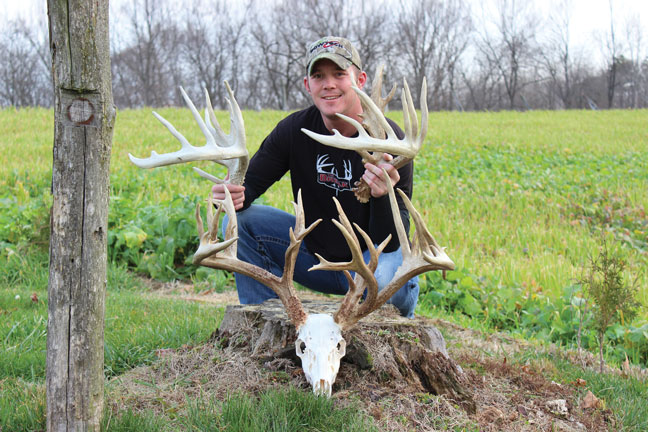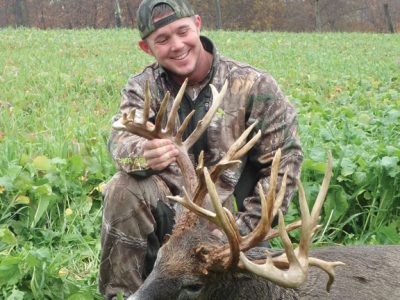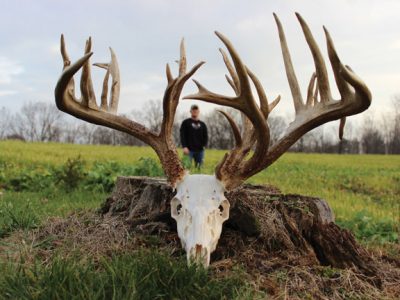Dan Coffman Buck

Story:
Yes, It’s THAT BIG
Published August 2016
By: Edson B Waite, Jr
Bowhunting gains a new totem for its pole, another from Ohio and a new No. 2.
Dan Coffman agreed to be a bowhunting mentor to his good friend, Josh Terry, in the summer of 2014. Soon afterward, Josh gained permission for them to hunt 400 acres in central Ohio.
The guys devoted many hours to scouting the land and identifying potential stand sites. They also put out minerals, corn and trail cameras to inventory the neighborhood whitetails.
Among the first bucks photographed were a wide-racked 9-pointer that might’ve scored in the mid-150s and a deer with a split tine on its left side. When the season opened, Josh hunted Big Nine, and Dan concentrated on the other distinctive whitetail.
Wish lists apparently aren’t carved in stone.
“In November, just as the rut was kicking in, Josh called to tell me he had a picture I needed to see. So, I went over to his house to have a look,” Dan said.
The photo was blurry, but there was no mistaking the enormity of the buck in it. The men couldn’t count the rack’s points, but there clearly were a lot of them.
A week or two later, one of Dan’s cameras captured a photo as well, also blurry.
Later that month, Josh actually saw the buck stand up in a field from about 100 yards away. It and a doe were heading for a part of the farm where his father was hunting, but they never came in range.
Later that month, Josh actually saw the buck stand up in a field from about 100 yards away. It and a doe were heading for a part of the farm where his father was hunting, but they never came in range.
They nicknamed it the Christmas Tree Buck.
“By mid-December, I was getting pictures of Christmas Tree on several cameras, but there was no rhyme or reason; no pattern; and never in daylight,” Dan said. “The only thing I could deduce was that he must be living inside the thickest, nastiest place on the farm.
“I was waiting for winter’s most brutal weather, when the deer usually come to a corn pile to survive,” he continued. “I also noticed from my photos that Christmas Tree always approached the corn from downwind, making it even tougher for me ambush him. I was trying to use the wind in my favor, but so was the buck.
“Just one time during the entire month of January did I get a daylight photo of him, and that’s when I was attending the (Archery Trade Association) show!”
When the 2014 season ended, Dan set his sights on finding the buck’s shed antlers.
“About mid-February, I noticed the buck had dropped his antlers, so I immediately set about finding them. I picked up one on Feb. 13. At that point, I knew this thing was going to be an absolute stud the coming year,” he said.
“I began studying every trail camera photo I got from that moment onward,” he continued. “I was shed hunting. I was measuring beds, looking for the biggest, and marking the locations. I found a ton of sheds, but not Christmas Tree’s right side.”
In preparation for the 2015 season, Dan and Josh rejuvenated their mineral sites and corn piles and hung several cameras.
They retrieved photos of the buck until June. At that time, its rack looked more fitting for a giraffe, just large velvet-covered pop cans.
A full month elapsed before Christmas Tree returned to mug for their cameras, and the antler growth was incredible. The fuzzy stumps had grown limbs, and the limbs begat limbs. It was obvious the rack might be carrying close to 300 inches.
“I have a buddy who is pretty good at scoring deer in pictures, so I took him several photos of the buck in August. I asked for total secrecy, but wanted his opinion,” Dan said.
Dan’s friend mulled over the photos for several days before declaring the rack might very well surpass the 300-inch mark, though he allowed as to how much bigger antlers seem in velvet.
“I studied every possible option — moon phases, topography, barometric pressure, everything and anything — that might help put that buck in front of me when the season opened,” he said.
“I started paying attention to a buddy at work who has more hunting years under his belt. He basically uses the moon, weather and topography to guide his hunts,” Dan added.
Dan’s friend mulled over the photos for several days before declaring the rack might very well surpass the 300-inch mark, though he allowed as to how much bigger antlers seem in velvet.
“I studied every possible option — moon phases, topography, barometric pressure, everything and anything — that might help put that buck in front of me when the season opened,” he said.
“I started paying attention to a buddy at work who has more hunting years under his belt. He basically uses the moon, weather and topography to guide his hunts,” Dan added.
Dan dedicated almost every waking moment to moving stands and cameras in his effort to pinpoint the buck’s favorite travel routes. Often, whenever he thought he’d patterned the deer, it changed its routine.
Christmas Tree had a knack for avoiding cameras, and he visited corn piles only at night.
When the buck dropped off the radar in late summer, Dan spent hours glassing neighboring farms. But he never saw the AWOL whitetail.
Just when he thought the animal had beamed aboard the starship Enterprise, the buck stepped in front of one of Dan’s “out-of-the-way” cameras on Sept. 29. He’d set that one up after accidentally spilling a bucket of mineral.
Dan had gathered up most of the spilled mineral, but he couldn’t get it all. He spread the remnants and hung a camera.
“He was hitting that mineral two or three times a week, while at the same time ignoring the corn piles,” Dan said.
“I wondered if he was somehow associating the corn piles with danger. Perhaps there was just too much human activity, even though I tried to control my scent.
“I started setting minerals away from the corn, just to judge the activity, and I started getting more pictures at other mineral-only sites. Then came another cooling-off period, and the deer disappeared.
“Friends told me they weren’t getting any bucks on camera either,” Dan said. “But I was spending all my time in an observation stand, glassing everywhere I could see.”
He was hitting that mineral two or three times a week, while at the same time ignoring the corn piles,” Dan said.
“I wondered if he was somehow associating the corn piles with danger. Perhaps there was just too much human activity, even though I tried to control my scent.
“I started setting minerals away from the corn, just to judge the activity, and I started getting more pictures at other mineral-only sites. Then came another cooling-off period, and the deer disappeared.
“Friends told me they weren’t getting any bucks on camera either,” Dan said. “But I was spending all my time in an observation stand, glassing everywhere I could see.”
The photos resumed in mid-October from both Josh’s and Dan’s cameras. By the third week, Josh got a picture on the side of the farm that’s home to wetlands and a dense thicket.
“We decided the buck was living in the wetland or the thicket. At that point, I knew I had to relocate a stand inside that thicket,” Dan said.
It would be incredibly difficult to access the thicket from the CRP field because of the wind direction, so Dan approached from the opposite side.
On Oct. 26, Josh got two pictures of the buck coming out of the CRP field and going toward the thicket, and returning the same way.
“That Tuesday, the wind was predicted to be perfect, and I was wound tight,” Dan said. “I went in for the evening hunt prepared for whatever might happen. I headed to a stand near the middle of a finger of woods sticking out into the cornfield and north of the thicket. I could see the entire cornfield, most of the CRP and part of the thicket.”
The deer came to within 30 yards, stopped, and turned broadside. The only reason Dan didn’t release an arrow right then is because he thought the buck would come even closer.
He was right.
“I drew quickly, locked on target, and released automatically,” he added. “I knew it was a good shot. I quickly swung the camera to film its retreat.
“The deer stopped at 80 yards, and I saw my blue nock sticking out of its side. While it stood there, I vomited over the side of the stand,” he said.
It was past sundown before Dan regained some modicum of composure. He was still aloft when his cell phone vibrated.
It was his best friend, Jeremy Mills, calling. They had agreed to meet after sundown. After several minutes of incoherent babble, Jeremy finally understood that Dan had shot his heart’s desire.
Jeremy was skeptical, at first, but hearing the tension in Dan’s voice convinced him that he needed to join him immediately.
Meanwhile, Dan finally got down from his stand and walked into the field where he’d last seen the buck. When he didn’t see the deer or blood, he walked to where Christmas Tree had taken the arrow.
“I found some blood there, but not the quantity I expected,” he said. “Still, there was enough to follow the trail into the field, and then I lost the track.”
Jeremy arrived about that time. The two guys walked across the field to the far woods line, and then decided to leave and give the animal more time.
They went to a friend’s house nearby and watched the footage Dan had taken during and after the shot. They couldn’t decide how to proceed, but the last thing Dan wanted was to crawl in his bed.
“I went to the highest place on the farm, where I could glass the entire field throughout the night. The field was well lit by the almost full moon,” he said. “I saw several deer, but not the buck or my blue nock.”
It had begun raining by the time Dan and Jeremy returned to the last spot of blood the next morning. Rather than go into the thicket from that side, they circled and entered it downwind.
“The plan was for Jeremy to walk the edge, while I snuck in quietly,” Dan said. “I had gone only 25 yards when I found the buck’s bed. There was a 4×4-inch spot of blood in it.”
Dan was sure they’d jumped the deer from that spot the previous night, and he was devastated.
Just after lunchtime, a man with a tracking dog arrived. After the dog jumped a live deer and was unable to get on the wounded one’s track, they abandoned that tactic.
“I then decided we needed to walk out the wetlands, but it was owned by another person I knew was out of town. Still, we went to his home, and his wife gave us permission to pursue the buck,” Dan said.
The search yielded nothing.
“Jeremy and I were about to the end. We had been at it since dark the previous night, and we were running out of options. After discussing everything, we decided to hit the thicket one more time, and so we headed that way.
“Then I remembered another CRP field on the adjacent property, near the thicket. We decided it couldn’t hurt to look there,” he added.
The pair found the owner of the CRP. He said they could look for the deer, but only if another hunter wasn’t hunting the farm. Next stop: the hunter’s house.
Because it was raining, the hunter was home. He not only agreed they could search the land, but he also wanted to lend a hand.
About halfway across the CRP, Jeremy fell flat on his face. Dan looked over as he got back to his feet. “Man, I tripped and busted this video camera. You’d better get over here and take a look at this,” Jeremy almost wailed. “I busted the lens!”
Dan wanted to ignore the broken camera, but Jeremy was insistent. When Dan joined his friend, and examined the equipment, Jeremy told him, “I tripped over that thing over there.” He was pointing to Dan’s deer, almost hidden in the tall weeds!





